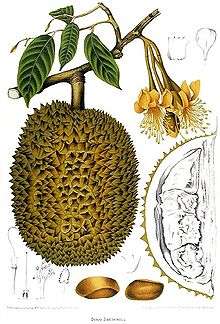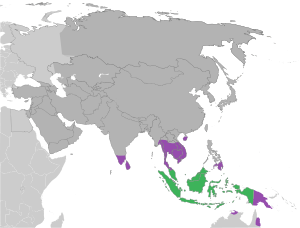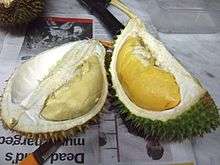Durio zibethinus
| Durio zibethinus | |
|---|---|
 | |
| Scientific classification | |
| Kingdom: | Plantae |
| (unranked): | Angiosperms |
| (unranked): | Eudicots |
| (unranked): | Rosids |
| Order: | Malvales |
| Family: | Malvaceae |
| Subfamily: | Helicteroideae |
| Tribe: | Durioneae |
| Genus: | Durio |
| Species: | D. zibethinus |
| Binomial name | |
| Durio zibethinus L. | |
 | |
| Native distribution of D. zibethinus[1] Exotic distribution of D. zibethinus[2] | |
| Synonyms[3] | |
| |
Durio zibethinus is the most common tree species in the genus Durio that are known as durian and have edible fruit also known as durian.
As with other durian species, the edible flesh emits a distinctive odour that is strong and penetrating even when the husk is intact. Some people regard the durian as having a pleasantly sweet fragrance; others find the aroma overpowering and revolting. The smell evokes reactions from deep appreciation to intense disgust, and has been described variously as rotten onions, turpentine, and raw sewage. The persistence of its odour has led to the fruit's banishment from certain hotels and public transportation in Southeast Asia.
There are 30 recognised Durio species, at least nine of which produce edible fruit. Durio zibethinus is the only species available in the international market: other species are sold in their local regions. There are hundreds of cultivars of Durio zibethinus; many consumers express preferences for specific cultivars, which fetch higher prices in the market.
Description
The wood of D. zibethinus is reddish brown.[4] Durio zibethinus is a medium to large buttressed tree, up to 45 m tall in dense lowland forests and 10-15 m in orchards and backyards; Bark dark red brown, peeling off irregularly. Leaves are elliptic or lanceolate-elliptic, 10-15 cm long, 3-4 cm wide, papery; base acute; apex acuminate, upper surface glabrous, glossy, lower surface densely covered with silvery or golden scales; secondary veins in about 15 pairs, distinctly looping near the margin; venation indistinct below. Petioles 1 -1.5 cm long, angular. Flowers are in fascicles of corymbose inflorescences. Pedicels 5-7 cm long; Calyx saccate, flattened at the base, with tube about 2 cm long and 1.5 cm in diameter; Petals white or creamy, spatulate, 5 cm long and 2 cm wide at the broadest part. Scientific Classification Kingdom: Plantae (unranked): Angiosperms (unranked): Eudicots (unranked): Rosids Order: Malvales Family: Malvaceae Subfamily: Helicterioideae Tribe: Durioneae Genus: Durio Species: D. zibethinus Murr Common Name Durian, Civet-fruit Figure 12 shows the tree (A), flowers (B), longitudinal section of fruit (C) and fruit showing conspicuous spines (D) of Durio zibethinus Stamen white, 4 cm long in 5 distinct phalanges, each filament with up to 12 reniform anthers dehiscing by a slit. Ovary is ovoid; Style slender, 4 cm long, stigma yellow. Fruit varies greatly in size; 15-25 cm in diameter, green to yellowish brown, with spines that are variable in length and shape. Seeds are chestnut brown, completely enclosed in a thick, white or yellow, soft, sweet, fragrant aril.
Ecology
D. zibethinus flowers are visited by bats which eat the pollen and pollinate the flowers.[4] The flowers open in the afternoon and shed pollen in the evening. By the following morning, the calyx, petals, and stamens have fallen off to leave only the gynoecium of the flower.[4]
Cultivars

Over the centuries, numerous durian cultivars, propagated by vegetative clones, have arisen in southeast Asia. They used to be grown with mixed results from seeds of trees bearing superior quality fruit, but now are propagated by layering, marcotting, or more commonly, by grafting, including bud, veneer, wedge, whip or U-grafting onto seedlings of randomly selected rootstocks. Different cultivars may be distinguished to some extent by variations in the fruit shape, such as the shape of the spines.[4] Durian consumers express preferences for specific cultivars, which fetch higher prices in the market.[5]
Most cultivars have a common name and a code number starting with "D". For example, some popular clones are Kop (D99 Thai: กบ – "frog" [kòp]), Chanee (D123, Thai: ชะนี – gibbon [tɕʰániː]), Berserah or Green Durian or Tuan Mek Hijau (D145 Thai: ทุเรียนเขียว – Green Durian [tʰúriːən kʰǐow]), Kan Yao (D158, Thai: ก้านยาว – Long Stem [kâːn jaːw]), Mon Thong (D159, Thai: หมอนทอง – Golden Pillow [mɔ̌ːn tʰɔːŋ]), Kradum Thong (Thai: กระดุมทอง – Golden Button [kràdum tʰɔːŋ]), and with no common name, D24 and D169. Each cultivar has a distinct taste and odour. More than 200 cultivars of D. zibethinus exist in Thailand.
Mon thong is the most commercially sought after for its thick, full-bodied creamy and mild sweet tasting flesh with relatively moderate smell emitted and smaller seeds, while Chanee is the best in terms of its resistance to infection by Phytophthora palmivora. Kan Yao is somewhat less common, but prized for its longer window of time when it is both sweet and odorless at the same time. Among all the cultivars in Thailand, five are currently in large-scale commercial cultivation: Chanee, Mon Thong, Kan Yao, Ruang, and Kradum.[6] There are more than 100 registered cultivars since 1920's in Malaysia[7] and up to 193 cultivar by 1992,[8] and many superior cultivars have been identified through competitions held at the annual Malaysian Agriculture, Horticulture, and Agrotourism Show. In Vietnam, the same process has been achieved through competitions held by the Southern Fruit Research Institute. A recently popular variety is, Cat Mountain King.[9]
By 2007, Songpol Somsri, a Thai government scientist, had crossbred more than ninety varieties of durian to create Chantaburi No. 1, a cultivar without the characteristic odour.[10] Another hybrid, Chantaburi No. 3, develops the odour about three days after the fruit is picked, which enables an odourless transport yet satisfies consumers who prefer the pungent odour.[10] On 22 May 2012, two other cultivars from Thailand that also lack the usual odour, Long Laplae and Lin Laplae, were presented to the public by Yothin Samutkhiri, governor of Uttaradit province from where these cultivars were developed locally, while he announced the dates for the yearly durian fair of Laplae District, and the name giver to both cultivars.[11]
Nutritional information
See also
- Breadfruit, an unrelated fruit that looks similar
- Jackfruit, an unrelated fruit that looks similar
References
- ↑ Durio zibethinus at worldagroforestry.org
- ↑ A traveler´s guide to Durian Season at yearofthedurian.com
- ↑ "The Plant List: A Working List of All Plant Species". Retrieved July 3, 2014.
- 1 2 3 4 Brown, Michael J. (1997). Durio – A Bibliographic Review. International Plant Genetic Resources Institute (IPGRI). ISBN 92-9043-318-3. Retrieved 2014-06-03.
- ↑ "ST Foodies Club – Durian King". The Straits Times. 2006. Archived from the original on 2007-12-15. Retrieved 2007-07-25.
- ↑ "Durian Exporting Strategy, National Durian Database (กลยุทธการส่งออกทุเรียน)" (in Thai). Department of Agriculture, Thailand. Archived from the original on 2010-07-26. Retrieved 2010-07-26.
- ↑ "Comprehensive List of Durian Clones Registered by the Agriculture Department (of Malaysia)". Durian OnLine. Archived from the original on 2007-04-07. Retrieved 2006-03-05.
- ↑ Boosting Durian Productivity
- ↑ Teo, Wan Gek (2009-06-23). "Durian lovers head north on day tours". The Straits Times. Retrieved 2009-09-19.
- 1 2 Fuller, Thomas (2007-04-08). "Fans Sour on Sweeter Version of Asia's Smelliest Fruit". New York Times. Retrieved 2008-11-20.
- ↑ Odourless durians to hit the market – The Nation
- ↑ "USDA National Nutrient Database". U.S. Department of Agriculture. Retrieved 2013-02-22.
External links
- Germplasm Resources Information Network: Durio
- Durio zibethinus (Bombacaceae)
- the controversial durian
- The durian: stinky fruit, killing fruit
- Nutritional value of durian
- Year of the Durian: a durian lover's travelogue and guide.
- A Durian How To.
